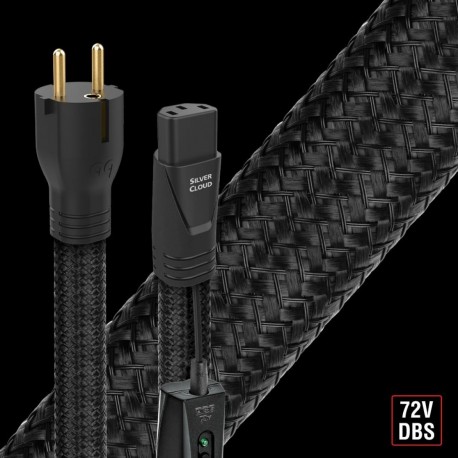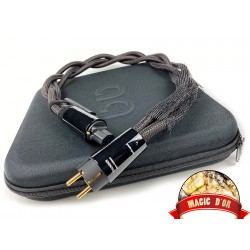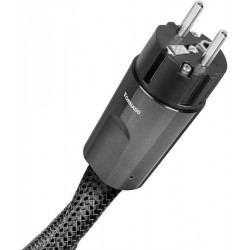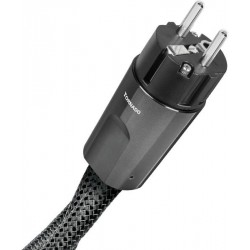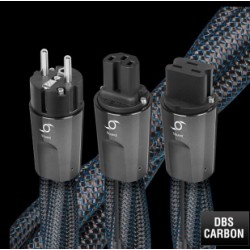No products
Prices are tax included
ZERO Tech: No Characteristic Impedance for Uncompressed Current Transfer
The integrity of any audio transient (instantaneous peak-to-peak voltage swing and current) delivered from a power amplifier to a loudspeaker has always been compromised. Whether the amplifier is valve or transistor, regardless of class of operation, the amplifier’s source impedance and loudspeaker’s load impedance are never critically matched. The speaker cable’s characteristic impedance is yet another culprit in a highly compromised non-linear electrical circuit. AudioQuest has always stated that all cables cause damage because the output is never as good as the input. However, by eliminating a speaker cable’s characteristic impedance, AQ’s ZERO Tech is an unprecedented step towards reducing that damage. The result is greater dynamic contrast, better audio transient response, and bass slam that are rendered seemingly without effort because the cable is not electrically restricting (strangling) the music.
High-Purity True-Concentric Perfect-Surface Silver and Perfect-Surface Copper+ Conductors
Superior metal and conductor geometry greatly reduce ear-fatiguing Transient Intermodulation (TIM) Distortion. Silver Cloud uses a carefully finessed combination of Perfect-Surface Silver (PSS) and Perfect-Surface Copper+ (PSC+).
GND (Ground-Noise Dissipation)
AC Ground wires provide protection from current-wiring faults, but they also act as antennas. Thus, they are subject to induced radio-frequency (RF) noise. This RF noise bypasses component power supplies and is typically coupled directly into a system’s most sensitive audio/video circuits. AudioQuest’s patented Ground-Noise Dissipation (GND) greatly reduces this distortion, yielding unprecedented levels of noise dissipation across the widest bandwidth (range) of radio frequencies possible. Our unique circuit topology utilizes a common-mode phase-cancelling array, in concert with proprietary dielectric materials which provide additional differential linear filtering. (US Patent # 9,373,439)
72v Dielectric-Bias System with CARBON-Level Radio-Frequency Trap (DBS)
All insulation is also a dielectric whose electrical properties affect the integrity of the signal. When the insulation is unbiased, dielectric-involvement (absorption and non-linear release of energy back into the signal flow) causes different amounts of time delay (phase shift) for different frequencies and energy levels, which is a significant problem for very time-sensitive multi-octave audio. AudioQuest’s multi-patented DBS creates a strong, stable electrostatic field which saturates and polarizes (organizes) the molecules of the insulation. This minimizes the nonlinear time delays, resulting in clearer sound emerging from a “blacker” background. The inclusion of an RF Trap (a technology developed for AudioQuest’s Niagara Series of power products) in the DBS battery pack further reduces radio-frequency noise. The DBS battery packs will last for many years. A test button and LED allow for the occasional battery check.
Directionality
All drawn metal strands or conductors have a non-symmetrical, and therefore directional, grain structure. AudioQuest controls the resulting RF impedance variation so that noise is drained away from where it will cause distortion. The correct direction is determined by listening to every batch of metal conductors used in every AudioQuest audio cable. When applicable, arrows are clearly marked on the connectors to ensure superior sound quality. For most models of AQ cable, the arrows not only indicate the direction that optimizes metal-directionality as part of Noise-Dissipation, but also indicates non-symmetrical attachment of shield and GND in order to optimize full-system performance.
ZERO: No Characteristic Impedance
PS: Perfect-Surface Silver and Perfect-Surface Copper + Conductors
TCC: True-Concentric Conductors Minimize Strand Interaction and Magnetic Confusion
NDS: Linear Noise-Dissipation Technologies
DBS: 72VDC Dielectric-Bias System with Carbon-Level Radio Frequency Noise Trap

